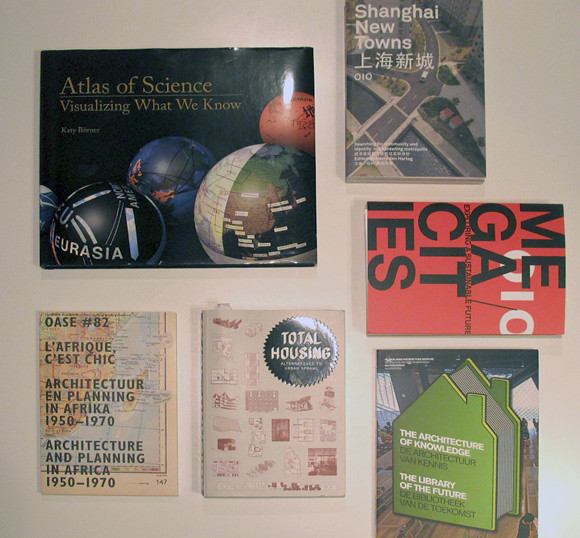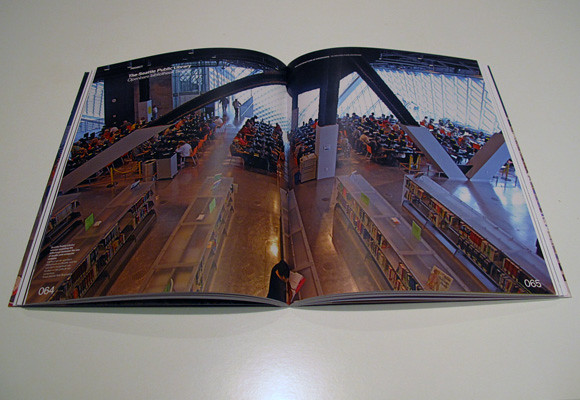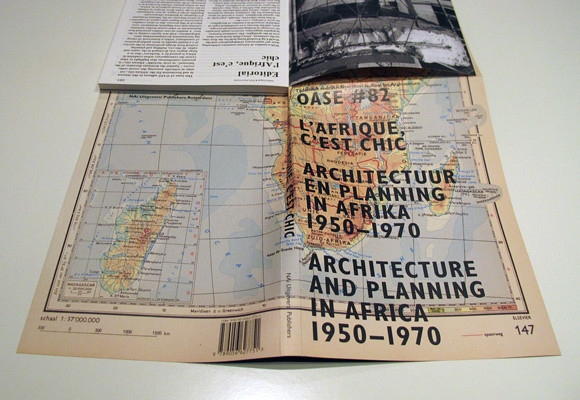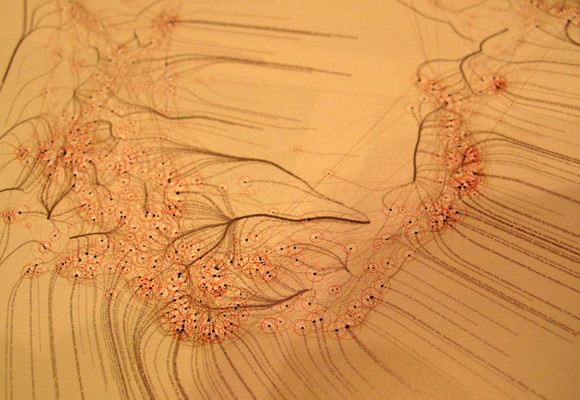The themes covered in this selection of six books range from housing typologies on an architecture level, to urban planning and the export thereof, to a theoretical discussion of mega cites, to the mapping and visualisation of global data sets.

------

Total Housing: Efficient Alternatives to Sprawl Illustrated
There has been quite some development in the area of housing in the first ten years of this century. Architects have begin to creatively rethink the floor plans and creatively integrate the developing of a housing unit into the thinking process while developing a scheme. Of course this did not always result in comfortable flats, but it definitely changed housing projects. Especially if wee ook at larger scale housing projects, with ten, twenty or even a hundred very similar unit types.
The specific interest definitely came from Europe, mainly offices in the Netherlands, that started experimenting and emphasising the joy of developing good housing schemas. It quickly gained ground and it can be said that now, after ten years, in a good international competition the floor plans are generally a lot more inspiring.
THe publication is rolling out exactly this. A collection of 61 examples of interesting and inspiring housing projects organised by size. This is ranging from a four unit project, B-Camp by Helen & Hard in Stavanger, Norway to the 750 unit project, Linked Hybrid by Steven Holl Architects in Beijing, China.
Each project is documented well with basic data such as m2 and cost and there are different strands of organisation running through the selection in order to develop a referencing system for cross reading. Further more the individual basic housing units of each project are summarised and on a comparison chart and there is a section with detailed construction drawings for a selection of the projects. Basically everything you need as an architect to make this book a perfect tool in the office.
Hoever this is not just for architects this publication, with its flaws in some structuring aspects, really is the most comprehensive and most recent guide to housing and in this sense could play an important role in the discussion on urban sprawl. The discussion however is not included, to be purchased separat.
"Total Housing is a demonstration of the virtues of high and medium density multi-family homes, and an antidote to urban sprawl. The selection of works in Total Housing (in hard copy and on its supplementary website: www.actar.com/totalhousing/) spans a period coinciding with the height of the housing boom, and consequent bust, experienced in most “developed” economies in the first decade of the 21st century.
From among the vast built production of this period, Total Housing selects 61 projects from 22 countries that exemplify outstanding innovations in construction systems, spatial organization, models of unit aggregation, and integration of the residential program into the complex of functions that make up our cities.
This book is a design manual as much as a reference for future good practices. Its structure follows a simple sequential order of the number of homes included in each project, revealing that interesting design solutions are found in big and small projects alike. The book also contains detailed plans of 17 of the featured projects." (Actar)
Anonymous, 2010. Total Housing: Efficient Alternatives to Sprawl Illustrated., Actar.
--------

The Architecture of Knowledge: The Library of the Future
The library is the classical architecture project for knowledge storage. A room designed to keep in neet rows and columns the books filled with words making up what we know.
With the rais of the computer and digitally produced and stored information this setting is bound to change. This fact plus the increasingly bured boundaries between producers and consumers are the topics this publication discusses. It looks of course at a range of architectural projects, but at the ame time organisation, technology, social and cultural aspect are investigated in depth to create a bigger picture.
Intriguingly, the neat rows of books, shelfs and corridors come under fire. Why not just storing everything in a big heap or in more living room sort of way where books wander around as they are used. Employing RFID technology and iPhone apps would sort out the problem of finding anything in this more dynamic environment.
"What will the library of the future look like? In an age in which information and communication are everywhere and the boundaries between producers and consumers of information are increasingly blurred, the question of what a public library might represent is urgent. The notion of a classical library in an academic environment with a formal collection and a permanent staff is already wavering. As a typology the library enjoys a rich history as an important component of public space within the city. As buildings libraries have always been a popular destination, which is why governments are still keen to employ them to enhance the image of their cities. At the same time, more and more libraries are expanding their scope by offering access to web browsers, on-line retrieval systems and other new media. What form and position will their physical structure need to assume in order to survive the changes that are taking place in this data-saturated realm of society – at present and in the future?
The Architecture of Knowledge offers new insights into this bastion of public knowledge and collective memory as well as fascinating prospects for its future. International experts present concepts of collective knowledge, the notion of public space, thoughts on the relationship between (new) media and (cultural) society, and insights into product management and reception. The result is a fascinating journey into the future of an age-old institution, obligatory reading for architects, librarians and users alike. " (Nai Publishers)
Werft, H.H.V.D., 2010. The Architecture of Knowledge: The Library of the Future Bilingual., NAI Publishers.
--------

Oase #81 - Architecture and Planning in Africa 1950-1970
The three times a year journal was running an issue on last century architecture in Africa. This covers the usual Oase topics of architecture urban design and landscape design and provides in depths contributions by a range of authors. This publication comes in a year were the interest in Africa was for a change word wide and positive. With the Football World Cup being held in South Africa earlier this year there was a lot of detailed attention directed to the otherwise largely generalised continent.
As the Editors point out in the editorial, Africa has also for quite some time been out of the spotlight from a spatial planning point of view. This wasn't always the case. In the late sixties for example there was great interest from european planners and a lot of project were being delivered by European or American companies on quite large scale.
The issue is basically digging out these aspects as it focuses on this period between 1950 and 1970 a very exciting time. A time were modernism was as a sort of general style being exported anda whole range of people started experimenting an implementing their ideas loosely connected to modernism.
There are of course the extending racial conflict deeply involved in al of spatial planning in this context an the publication is a various points uncovering the complicated entanglings between idea, concept, practice, and ideology mixing politically, religious and professionally.
"For the last few years there has been a strong revival of interest in the African city across numerous disciplines, including anthropology, sociology and urban history. Since the mid-1990s, when Rem Koolhaas placed urban conditions in Lagos on the agenda as a research topic, other architects and planners have rediscovered the African continent. Architecture historians and heritage agencies are now also studying modern architecture in Africa, which is largely ignored in overviews of twentiethcentury architecture.
OASE 82 shares this current fascination for modern architecture and planning on the African continent, but also expresses reservations. This edition presents a critical historiography of modernistic architecture from 1950 to 1970, which in many cases still defines the urban landscape in African centres. A photographic project by the young Congolese photographer Sammy Baloji about Avenida Lenine in Maputo, Mozambique, presents a striking profile of twentieth century architecture in a former Portuguese colony." (Nai Publishers)
Lagae, J., Avermaete, T., Bruijn, D. De, October 2010. Oase #81, Nai Publishers
--------

Shanghai New Towns: searching for community and identity in a sprawling metropolis
How to invent identity? this could as well be the subtitle of this publication initiated by urbanlanguage.org and sponsored partially by The International New Town Institute. This problem is well known to everyone who has once attempted to create something from nothing.
There is not nothing, but it is pretended there is nothing and this complicates the problem even more. It results in "How to pretent to invent identity" I guess. However you put it, the dilemma has many aspects and there is no easy way out.
The publication is tackling this problem head on and offeres a well researched and presented context with detailed references historical and contemporary as well as detailed project documentation. The really interesting part however for me are the photo essays. For example the section 'New Citizens' by Chen Taiming from page 321 to 368 nails the problem, clash of identities.
China is expecting a lot of its citizens and this book manages to portrait the struggle of the different disciplines involved, from the politician to the developer the imported planner right to the actual inhabitant or still missing inhabitant.
"Each year, more than 15 million Chinese leave the rural areas of China and move to the cities. This figure exceeds 300,000 in the case of Shanghai. Before 2015, the majority of China’s population will be living in urban areas. Shanghai New Towns documents and analyses the meteoric rate of urbanization of the countryside round Shanghai, most particularly the part played there by new towns and new villages. This decentralized planning model takes its cue from classic examples from Russia and Western Europe. A few pilot new towns have been developed on paper with help from Western designers and then adapted to suit Chinese standards. This book shows how the plans have been put into practice. Photos, essays by Chinese and Western critics and descriptions of projects illustrate what daily life looks like and how these new cities function within the Yangtze River Delta Metropolitan Area as a whole. It dwells at length on the international exchange of knowledge and the differences in method."(010 Publisher)
Hartog, H. den ed., 2010. Shanghai New Towns: Searching for Community and Identity in a Sprawling Metropolis, Rotterdam: 010 Publisher.
--------

Megacities - Exploring a Sustainable Future
This book covers the theoretical field for this christmas selection. It covers the scholarly discussion around urban areas, featuring the main urban thinkers of the beginning of the 21st Century, starting with Peter Hall, Saskia Sassen, Richard Sennett and David Harvey, as well as for example Richard Rogers. Te title i not only programatic, but at the same time the name of the foundation based in the Netherlands who has initiated the book. Jan Hoogstad had started the foundation about 15 years back with a small group in an attempt to comprehend the essence of urban growth, up to and including the Megacity level, in a context of global cultura ad economic diversity.
With this publication the foundation focuses, as currently fashionable, on sustainability as indicated by the subtitle. However, this new publications more than just a fashion trend, it is first and foremost a retrospective, marking the anniversary and summarising the great amount of publication, lecturing and seminar work undertaken since the founding of Megacities.
THe ranging chapters are in this sense mostly lectures that have been delivered as part of a previous Megacities conference or event. As a collection it however, makes quite a summary of modern thinking about urban from many different perspectives and characters. This makes for a great read and the publication manages to actually spark a discussion between the different contributions even though they might have been initially separated by time.
"Urbanization has evolved dramatically from monocentric settlements to polycentric networks and megacities of previously inconceivable size and population. This escalation of quantities and scales has ignited a deep and growing fascination for the phenomenon of megacities. The book’s point of departure is to define megacities and understand their processes and systems of organization. From this discussion it aims to glean lessons for researchers, practitioners, politicians and the general public. The Megacities Foundation, which initiated this discussion and book, has set a benchmark in the architectural profession, and has actively encouraged debate on megacities for the last fifteen years by inviting leading international academics and practitioners from the fields of architecture, economics, geography, sociology and urban planning. This book offers a compilation of the best lectures about the definition, evolution, governance and design guidelines of megacities. In addition, it incorporates reflections on what megacities could mean in the Dutch planning context. Megacities is a body of knowledge for comprehending the essence of urban growth and exploring a sustainable future." (010 Publishers)
Buijs, S., Tan, W. & Tunas, D., 2010. Megacities - Exploring a Sustainable Future, 010 Publishers.
--------

Atlas of Science: Visualizing What We Know
Thi is really the picture book in this selection. If you are more after something to look at than reading from this is your choice. THe knowledge mapped out in pretty maps and illustrations ranging from historic to futuristic 'What we know' and how we know it.
Katy Boerner tries really hard with this full colour and large size 'atlas' to cover this vast and extremely divers area se has discovered here. It i a difficult field but who if not her must really know what we know. Katy Boerner is running the director of the Cyberinfrastructure for Network Science Center at Indiana University.
The idea here is really to draw maps of everything we, the human race has ever known, ranging from publications to patents to conversations. This is of course set very much in an academic context and has a specific American focus since the research is undertaken there.
Nevertheless the project mapps out a vast amount of data sets and bring some spatial order into mountains of data points. This is archived with a lot of network analysis and mapping employing sophisticated mathematical models and algorithms. THe key to this is probably the data handling. Each set contains millions of records and in this sense is ia merely a thought that defines the fina product rather than any manual labour.
And this is then probably also the key issue for the book, this science of science as a rather detached proces has temporarily lost its actual fascination a bit I fear and also the extremely strong personalisation of each documented project can't brush this of. As a important point of critique since this is an 'atlas', the graphics need to be worked on if it wants to be what it is.
Nevertheless this is an initial result of an investigation charting new territory and manages to surprise and enlighten what we probably would never have go close otherwise, a must have for mappers and data freaks.
"Cartographic maps have guided our explorations for centuries, allowing us to navigate the world. Science maps have the potential to guide our search for knowledge in the same way, helping us navigate, understand, and communicate the dynamic and changing structure of science and technology. Allowing us to visualize scientific results, science maps help us make sense of the avalanche of data generated by scientific research today. Atlas of Science, features more than thirty full-page science maps, fifty data charts, a timeline of science-mapping milestones, and 500 color images; it serves as a sumptuous visual index to the evolution of modern science and as an introduction to "the science of science"—charting the trajectory from scientific concept to published results.
Atlas of Science, based on the popular exhibit "Places & Spaces: Mapping Science," describes and displays successful mapping techniques. The heart of the book is a visual feast: Claudius Ptolemy's Cosmographia World Map from 1482; a guide to a PhD thesis that resembles a subway map; "the structure of science" as revealed in a map of citation relationships in papers published in 2002; a periodic table; a history flow visualization of the Wikipedia article on abortion; a globe showing the worldwide distribution of patents; a forecast of earthquake risk; hands-on science maps for kids; and many more. Each entry includes the story behind the map and biographies of its makers.
Not even the most brilliant minds can keep up with today's deluge of scientific results. Science maps show us the landscape of what we know. " (MIT Press)
Borner, K., 2010. Atlas of Science: Visualizing What We Know, MIT Press.
Tidak ada komentar:
Posting Komentar